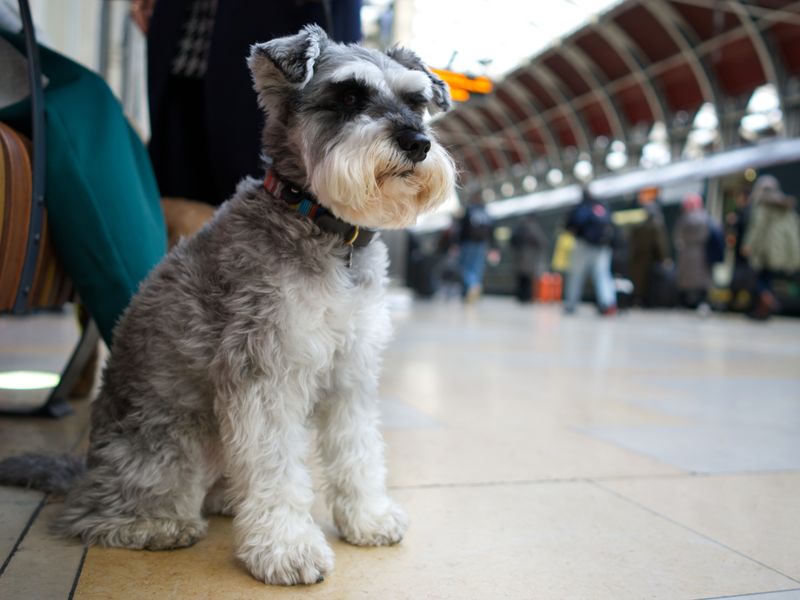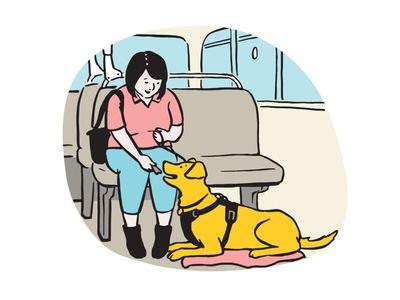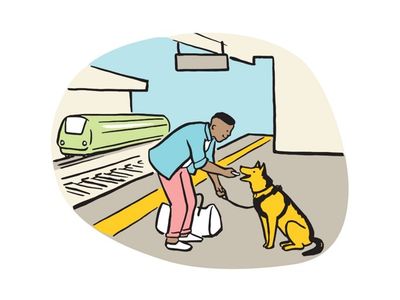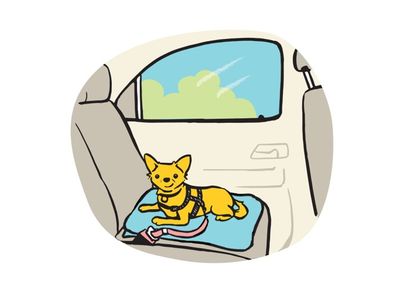How to travel on public transport with your dog
Training your dog to use public transport can open up a world of new adventures.

No car? No problem. Public transport can be a gateway to new adventures for you and your dog.
Dogs thrive on new smells and sights. So, using public transport to explore somewhere new with your best pal can make for an exciting adventure for some dogs. A chance to step off the beaten track.
Here are some top tips to help you feel comfortable bringing your furry friend along for the ride.
On this page...
Skills for travelling on public transport
Some dogs can find new experiences scary or stressful, so it’s important to prepare ahead. Travelling may not be the right choice for your dog. In which case, there are lots of fun activities you can try at home. Here are some cues and skills that your dog should know before you hop on public transport with them. Having mastered these together, you’re in for a calmer, safer, and altogether more enjoyable experience.
Sit
Sitting by you is a key skill for your dog to know before venturing out into the world. Knowing when and how to sit can also help them stay safe in moving vehicles.
Lie down
Knowing a lie down cue can help your dog get into a comfortable position and help them feel relaxed while travelling.
Settle
Knowing how and when to settle is a useful skill for helping your dog relax on busy or long journeys.
Leave it
You wouldn’t eat from the floor of public transport. And neither should your pup. They could pick up harmful objects or food. So, making sure they’re able to ‘leave it’ is an important skill.
Focus
1, 2, 3–eyes on me. Getting your dog's focus and attention is useful when you're out and about. Master this, and you'll be prepared to navigate distracting environments together.
Top tips for dog owners
For more advice on keeping your dog healthy and happy, sign up to our monthly newsletter.
Seasonal advice, training tips, and even pooch-friendly recipes. With all of this and more at your fingertips, we've got you and your furry pal covered.
What to consider when travelling on public transport with your dog
Mode of transport
Always check that the mode of transport you wish to travel on allows dogs. You can usually find this information online in what's called the 'conditions of carriage.'
Don't assume that all transport will take dogs. And if they do, you’ll likely have to follow certain rules. Always check with your travel provider before you set off.
- Trains: usually accept dogs, up to two per passenger
- Coaches: usually don't accept dogs
- Buses: usually accept dogs at the driver's discretion
- Taxis: sometimes accept dogs. Always contact the company beforehand to let them know you’re travelling with a dog. Some taxi apps now have an option to choose a pet-friendly cab.
Using the London Underground
The ridges on escalators can damage your dog's paws. So, make sure to carry your dog on escalators, or use lifts.
You can use TFL's 'plan a journey' feature to map out a route using stairs and avoiding escalators.
Factors to consider
Ticket barriers: however small and agile you think your dog-about-town is, always take them through the accessible ticket barriers. This gives your pup more space and time to get through.
Time of day: have a think about the time of day you’ll be travelling. It’s always easier to travel with a dog when public transport is less busy.
Crowds and small spaces can be stressful enough for us humans. So, think about your furry pal down there between the unfamiliar legs and baggage.
Remember:
- assistance dogs are allowed on all modes of transport by law. It’s an offence to refuse entry to a person and their assistance dog.
- you are responsible for keeping your dog under control at all times, whether on public transport or not.
- not everybody loves dogs as much as we do. Some may even have allergies or phobias. So, you'll sometimes come across someone who would rather not sit next to your pooch.
Why travelling on public transport isn't for every dog
Just as some humans aren’t keen travellers, some dogs can find public transport a stressful and scary experience. Make sure to consider your dog's needs and welfare before travelling.
Sometimes, public transport isn't an appropriate way of travelling with your dog. For example, after an operation at the vet, or when it's hot.
Put your pup on the right track
Get your pup their very own Tailcard - a fun way to show that they've mastered the basics of travelling safely by train.
What to take with you
When travelling with your dog on public transport, it's important that you bring along anything your dog might need:
- Water: public transport can be hot – whatever time of the year. So, it's important that you take water and something for your dog to drink from.
- Poo bags: hopefully your dog won't need to go while you're on the bus or train. Make sure to give them a chance to go beforehand. But it’s always good to be well stocked with poo bags. You can get Dogs Trust yellow bags from our online shop.
- Treats: we fully believe in reward-based methods. So, it’s useful to have some small treats for when you want your dog to do something. If it’s a longer journey, you may want to consider taking an activity-based treat. Things like Kongs and snuffle mats can keep your dog occupied.
- Meals: if you're travelling all day, remember your dog will need their usual meals.
How to train your dog to travel on public transport
Preparing your dog for travel
When training a new skill or in a new environment, it’s important to introduce your dog positively and gradually. Make sure they’ve mastered the basic skills they need. Then, you’re ready to start training around whichever mode of transport you'd like to start them with. A bus stop or train station, for example.
Make sure you have plenty of tasty treats handy, and some water. Always go at your dog's pace. And go back a step in the process if they seem worried or unhappy at any point. You'll need lots of short and fun sessions over time to grow the skills for using public transport with your dog.
How to train your dog to travel on a train, bus, or in the car
Here are some useful steps for getting going with your pooch:
Introduce them to the new environment
Try to build a positive association with their new environment. You can do this by rewarding them with a treat or some praise every few seconds for being calm. You can also practice some familiar and fun cues, like sit or lie down, that you both know well.
Reward as the train or bus approaches
As a train or bus approaches and moves away, give your dog plenty of treats. This is so they continue to build on that positive association. Remember to start as far away as your dog needs to remain relaxed and happy.
Then, gradually, move closer to the approaching …
Practice during quiet times
Once your dog’s happy with the train or bus approaching, you're ready to get on. When you first start training this step, use a quiet platform or bus stop at a quiet time of day.
Keep rewarding them to keep the experience positive. Limit the journey to a short one to …
Build up journey times
Once your canine companion is comfortable and relaxed on short trips, start to gradually build up the journey times. Keep rewarding them and make the experiences positive. They will keep growing in confidence and they will be …
The bottom line
From the open spaces of the countryside to the vibrant streets of a nearby town or city, public transport can be a brilliant way to take your dog on adventures.
But it’s important to make sure your dog is prepared for travel, and equally that the travel is prepared for them.
Now you’re clued up, it’s time to start planning your trip. Bon voyage!






